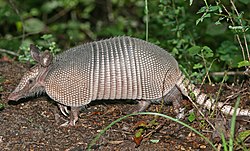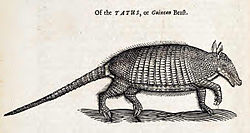| Armadillo Temporal range: Late Paleocene – Recent | |
|---|---|
 | |
 | |
| From top to bottom: nine-banded armadillo (Dasypus novemcinctus), pink fairy armadillo (Chlamyphorus truncatus) | |
| Scientific classification | |
| Kingdom: | Animalia |
| Phylum: | Chordata |
| Class: | Mammalia |
| Superorder: | Xenarthra |
| Order: | Cingulata |
| Families | |


Armadillos (Spanish for 'little armored ones') are New World placental mammals in the order Cingulata. They form part of the superorder Xenarthra, along with the anteaters and sloths. 21 extant species of armadillo have been described, some of which are distinguished by the number of bands on their armor. All species are native to the Americas, where they inhabit a variety of environments.
Contents
- Etymology
- Classification
- Evolution
- Distribution
- Characteristics
- Size
- Body temperature
- Skin
- Behaviour
- Diet and predation
- Defense
- Movement
- Reproduction
- Armadillos and humans
- Science and education
- Culture
- See also
- References
- Further reading
- External links
Living armadillos are characterized by a leathery armor shell and long, sharp claws for digging. They have short legs, but can move quite quickly. The average length of an armadillo is about 75 cm (30 in), including its tail. The giant armadillo grows up to 150 cm (59 in) and weighs up to 54 kg (119 lb), while the pink fairy armadillo has a length of only 13–15 cm (5–6 in). When threatened by a predator, Tolypeutes species frequently roll up into a ball; they are the only species of armadillo capable of this.
Recent genetic research has shown that the megafaunal glyptodonts (up to 1.5 metres (4.9 ft) tall with maximum body masses of around 2 tonnes), which became extinct around 12,000 years ago are true armadillos more closely related to all other living armadillos than to Dasypus (the long-nosed or naked-tailed armadillos). Armadillos are currently classified into two families, Dasypodidae, with Dasypus as the only living genus, and Chlamyphoridae, which contains all other living armadillos as well as the glyptodonts. [1]





